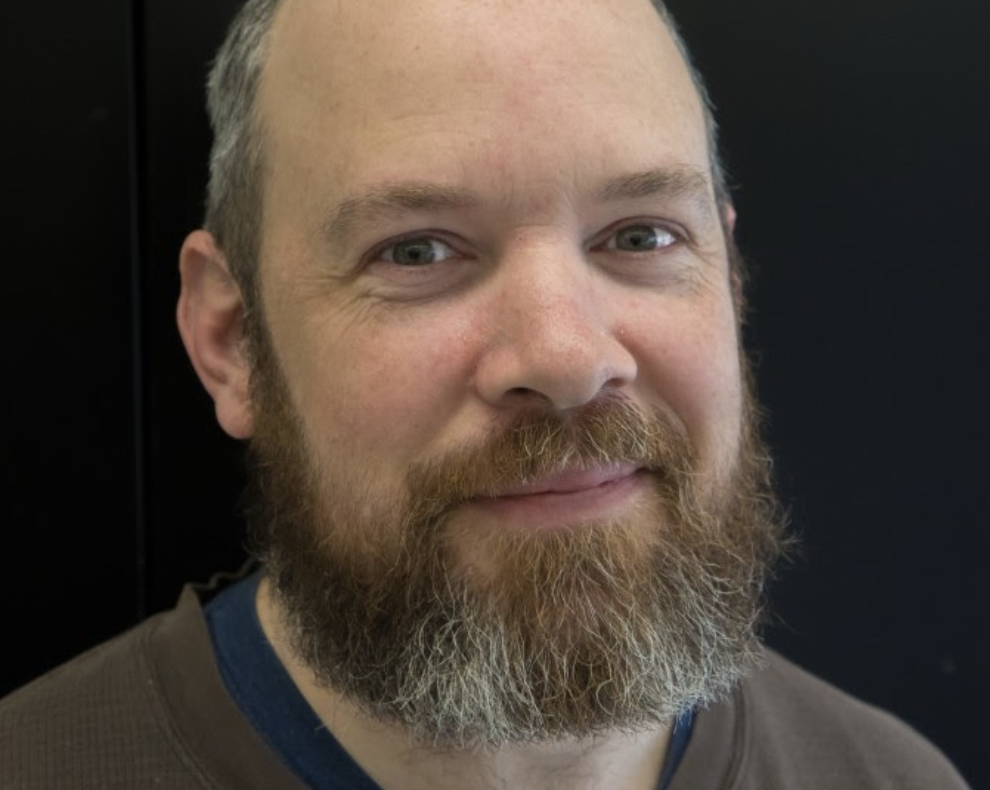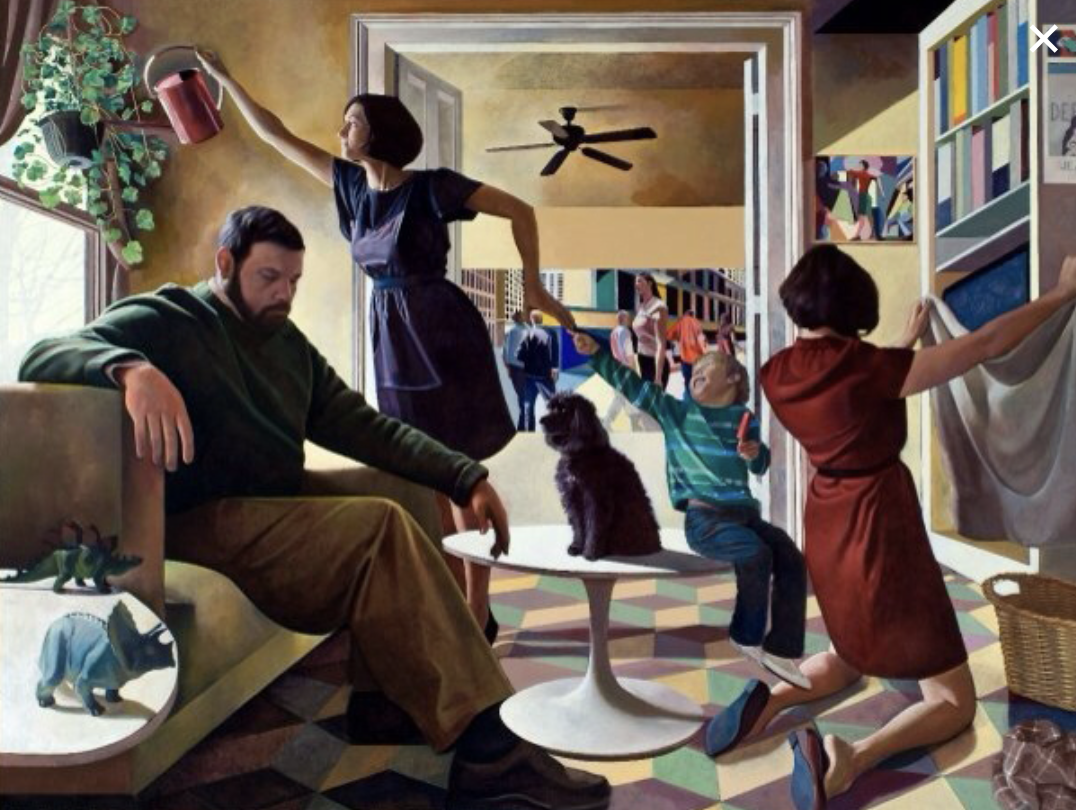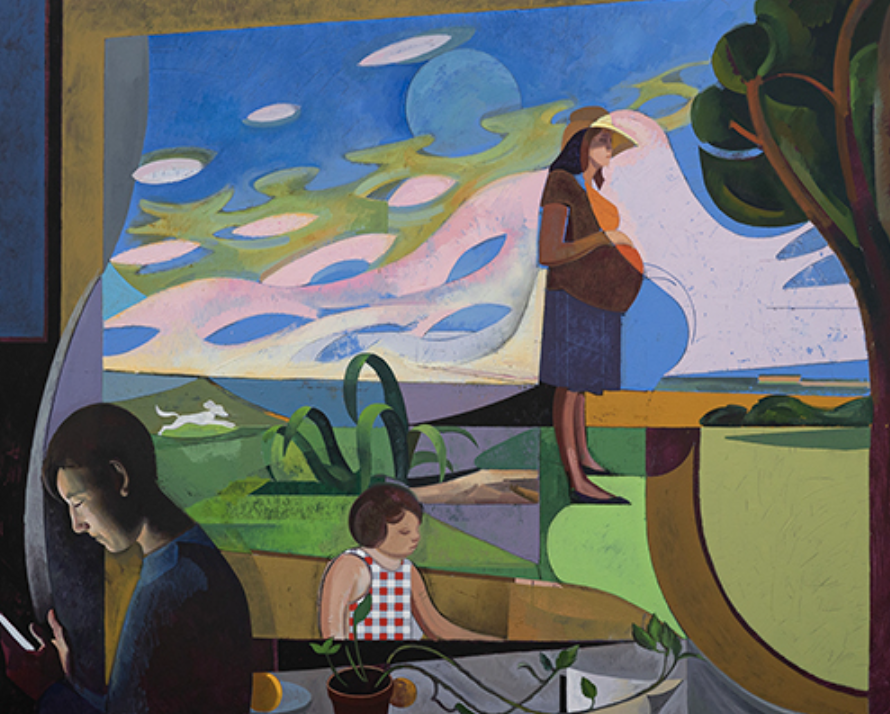Jeremy Long (Visual Arts '89) Discusses His Career and Experience at The Academy
Alum Jeremy Long (Visual Arts ‘89) began his formal arts education in the late 1980’s at The Academy, where he spent his time studying art history, drawing, and printmaking.
Upon graduation, Jeremy attended the Kansas City Art Institute where he earned his undergraduate degree in fine arts. Afterwards, he earned his MFA at American University. Jeremy’s soon-to-be wife and fellow artist, Colleen came into the picture when Jeremy asked her to pose for a portrait assignment. Since then, Colleen and the rest of Jeremy’s family have played a central role in his work. Between figures, landscapes, abstraction, and still lifes, Jeremy’s work is described as demonstration painting, often associated with the Renaissance era.
Jeremy’s September Bowery Gallery show premiered pieces he’s been working on for 2-3 years. We sat down Jeremy to discuss his career and time at The Academy. Read more below.
Header painting: Family Group with Still Life, 2017
What’s it like being back?
It’s been a bit of shock, even pulling into the parking lot. It’s been three years since I’ve been able to visit Chicago, but this is the first time I’ve visited The Academy since 2003. It’s hard to believe it’s almost been 20 years. I left [my teaching position at] The Academy because I was offered a position to go teach at Knox College in Galesburg, IL. I moved back to Chicago briefly in 2006 but wasn’t able to make it over to The Academy. After Illinois, I spent some time crossing states off my list in New England and the Midwest. I’m still taking it all in. It’s been a while.
A lot has changed since you’ve been here last, can you talk about that?
One of the first things I noticed was that one of my favorite teachers is not teaching anymore. He was one of the original teachers in ’81 or ’82, but I think he left in 2009. In my mind, that’s been the biggest difference. Other than that, the spaces look the same. From what I remember, the only thing that’s changed is some furniture.
What is your Academy story? You taught here and attended, correct?
Yes! I was a student here and that was probably the most significant thing to happen to me as far as my education is concerned, without a doubt. I always had an interest in drawing when I was younger, so my mother and I – she was a single mother living in Lincoln Park – got a newspaper ad from my grandmother about The Academy in ’83/’84. That was my mother’s first awareness of the school. Of course, I vividly remember my audition, which was in the original building on Adams.
What did the audition look like back then?
It was relatively formal. I remember going to great lengths to take the drawings that I felt had quality to them. I mounted them and put a plastic protector over them. Altogether, there were twenty works and you had to make an appointment, but I don’t remember what time of year. Then, I had to present the work to the art chair at the time and speak about my process. I’m not sure how much time passed, but I received the acceptance letter, which was a big deal to me. I started attending at the Adams building, which was a huge shift coming from Catholic school. As you can imagine, it was relatively conservative at the Catholic school, so it was mind-blowing to meet so many new types of interesting students at The Academy. It was very intimidating, but there was so much freedom to it. The old building was a stone’s throw away from downtown, so you got to spend your lunch break roaming around downtown.
The Painting Lesson, 2006, which hangs in The Academy’s front entrance.
What was the class structure like?
You had the opportunity to work on your art 3.5-4 hours a day, which was the beginning of developing a work ethic. The chance to work alongside fellow students in similar disciplines was truly unique.
You mentioned a teacher at your audition – who was that person to you?
Yes, Glenn Rupert was the department chair for the visual arts. He was a longtime mentor of mine. He wore a lot of different hats, but his primary medium was printmaking, which was a rather esoteric artform. Introducing that to 14-year-old students was amazing. He also taught art history and drawing, where I spent the most time with him. He was a serious-minded man, but very passionate as well.
What was your favorite part of being at The Academy?
One of the biggest lessons I learned from Glen is that we’d learn more from our peers than from him. It meant we’d all work together with this shared enthusiasm every day. If one of us were having difficulties – say for instance, pushing past a plateau or developing some sophisticated ideas, it was nice having others around learning at the same pace. Especially upperclassmen, which I ended up following some of them to undergraduate school. When I went to the Kansas City Art Institute, I worked with a lot of serious students. That was really important to me.
Ithaca Home, 2010
Your work involves a lot of family. What other themes do you think influence your work?
The two things you have to decide are “what are you going to say?” and “how are you going to say it?” To answer your first question, [family] has always been what’s in arm’s reach. I was very committed to working directly from observation for a considerable amount of time. That was something that allowed landscapes, cityscapes, and self-portraiture to happen often. Then as life kept happening, it became using them as a vehicle to make a body of work.
One of the things I read in one of your past interviews was that much of your work comes from dissatisfaction. Do you think that trait has made you a better artist and are there any pieces you are completely satisfied with?
The easiest way to answer that question is to say that the latest thing I’ve done has felt like it’s moved above the things prior to it. I’m always trying to figure out better ways to say what it is I’m going to say. The dissatisfaction comes from the fact that I’m always trying to make these ambitious paintings that, at this point, take two or three years to make. I feel like I get somewhere with them and then move on. I’m not completely dissatisfied with them, but I’m ready to move to the next thing. This class will be a nice experience to just show some of the work I’ve done. Especially with the show that just happened in New York. I feel better about that than anything I’ve done in the past.
Large Study for Ithaca Landscape, 2020
What’s one piece of advice you’d give to a student entering The Academy?
Just to devour as much as you can. The big thing about The Academy is that you’re going to have a leg up. This was so pronounced when I went to the Art Institute; just how accelerated our education was. We certainly felt lucky and even a little arrogant, but proud to have spent four years here. To be able to walk in and show them who’s boss in a way. Don’t pass up on that opportunity to learn all you can in this setting.
What do you see in Academy students today that is different when you were enrolled?
I can’t really speak to that because the last Academy students that I’ve seen or worked with were from 2003. I look forward to taking a look around at some of the student work here in a few minutes.
One thing I forgot to mention was how close I was with students from other departments when I attended. I certainly dated a few people from the Dance Department that I remember fondly! But I remember going to their performances and being blown away by what they’d learned. At the time, it made me want to pick up a guitar and learn to play, so I did. I put it away for 25 years or so, but recently started playing again. I also got along great with the Theatre Department.
Was that inspirational to see the other departments?
It was more than that – they were great friends. I don’t remember having any long, intellectual engagements with them about their craft, but we supported each other all the time.




